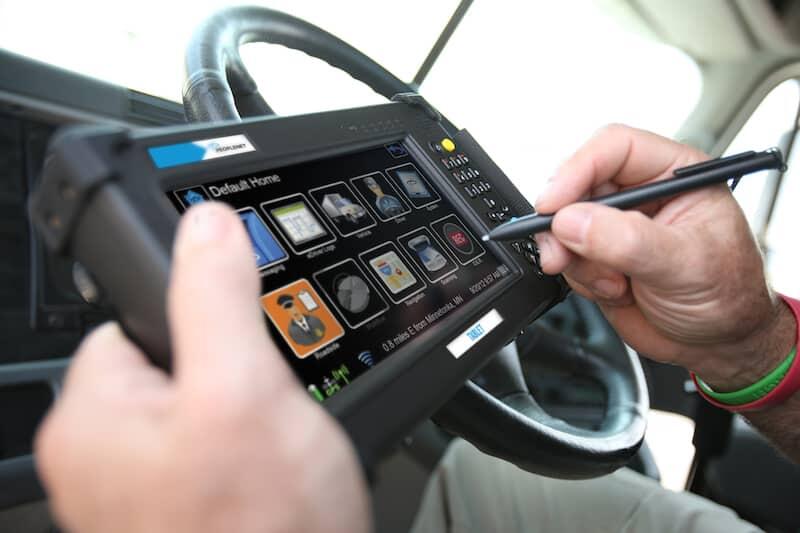Cold Weather is Here!
This week's safety bulletin discusses the importance of fuel additives during the winter. Read the full safety bulletin here and subscribe to receive future safety bulletins straight to your inbox.
With the start of the winter season, it is vital to remind your drivers how to care for their fuel.
- Diesel supplements should be added to ultra-low sulfur diesel fuel when temperatures drop below 32 degrees.
- Plug your engine block heater when the temperature is below 32 degrees. Start and let run trucks not being used to bring the unit up to the average operating temperature.
- The initial start-up procedure should be as follows: Complete the unit's pre-trip, unplug the block heater, turn the ignition switch on, wait for the glow plug lights to go out, start the engine, and leave it running until engine operating temperatures increase.
- Drivers of trucks equipped with air brakes should purge air tanks daily. If the unit has an air drier, bringing the PSI to 120 will automatically purge the system.
- If you are driving in snow, ice, slush, rain, etc., before parking the unit for the day, you should lightly apply the brakes while the unit is moving to dry the brake shoes, drums, rotors, and pads so the brakes do not freeze while parked.
- Ensure the windshield washer solvent is full and all windows are clean.
- Remove any ice-snow build-up from steps and grab handles to prevent a slip or fall.
When parking the unit, if heavy snow is in the forecast, ensure it is not parked on an outside dock or near a building overhang. Snow can drift off the building, causing excessive accumulation on top.
Fuel Additive Use during Cold Weather Conditions
Using fuel additives to prevent jelling becomes essential during the colder weather. Add fuel additives anytime the ambient temperature is below 32 degrees F. Power Service and Penray are popular manufacturers of fuel additives, and both companies have two different products available through Navistar and Idealease locations.
Power Service:
- Diesel 911 will reliquefy gelled diesel fuel and de-ice frozen fuel filters. Only use Diesel 911 when your fuel is gelled; remember that this will NOT prevent gelling.
- Power Service Diesel Fuel Supplement + Cetane "White Bottle" is to be added to the fuel at each fill when the ambient temperature is < 30 degrees F; this is the additive you should use regularly during the winter months.
- Both Diesel 911 and the Diesel Fuel Supplement + Cetane Boost are compatible and can be used simultaneously.
Penray:
Winter Thaw Emergency Diesel Fuel Supplement
- Dissolves already gelled fuel fast and reduces clogging of fuel filters
- Prevents ice crystal build-up in fuel lines and filters by disbursing moisture
- It eliminates hard starting and pounding, improves combustion, and excessive smoking.
- 100% compatible with low sulfur fuel and fuel blends.
Winter Thaw Emergency is ONLY USED WHEN THE FUEL IS ALREADY GELLED!
Winter Pow-R Plus Diesel Fuel Supplement
- ULSD compliant
- Prevents gelling of diesel fuel and ice crystal formation
- Reduces cold filter plug point b as much as 30ºF
- Helps enhance cetane and improve fuel economy.
- Utilizes HAFI® technology.
- Improves cold-weather starting.
- Stabilizes and prevents corrosion.
- Helps reduce emissions and improves lubricity
Preventing Driver Injuries in the Fall and Winter
Slip/trip and fall injuries are the most common injuries for drivers, most of which occur during the winter months. Thousands of professional drivers are seriously injured yearly because they ignore winter conditions. Working on ice and snow requires full attention and awareness.
Remember, it is our primary goal that you go home to your family and friends the way you came to work today, safe and healthy.
- Always wear proper footwear. A full-support leather shoe with a rugged, non-slip sole. Use non-slip covers on shoes (Yak Trax, etc.)
- SLOW DOWN, always take your time.
- Always watch where you walk. Snow can accumulate on top of ice in and around truck parking areas.
- Take small steps and check your footing with each step.
- Look for ice on all handrails and hand grabs before using them.
- Use gloves for better grip.
- ALWAYS use three points of contact when exiting/entering your tractor or trailer or getting on the catwalk behind the cab.
- Always use your seat belt.
- Slow down on the roads.
DOT Clearinghouse Annual Query Deadline is Approaching Soon!
The annual DOT Clearinghouse deadline is only a few weeks away. Annual queries for all DOT-regulated CDL drivers are due by January 1, 2024. If you still need to run a query on each CDL driver you employ (including yourself if you are an owner-operator), you must do so by this date.
Failure to run these annual queries could lead to fines of up to $2,500 per driver.
Last year, the system was overwhelmed by the large volume of traffic trying to register and log into the site at the end of the year. If this occurs in the weeks leading up to the deadline, as projected, it could make it difficult for employers to meet their requirements before the deadline.
Our suggestion? Take care of this requirement now before the surge occurs.
About the Annual Clearinghouse Query:
Employers must run at least one Clearinghouse query on each CDL driver annually. You can run a full or a limited query, but if a limited query shows information on a driver's record, you will be required to run a full query within 24 hours. Failure to do so will result in the driver being pulled from safety-sensitive functions until you can complete the query.
Here are the differences in the queries:
- A limited electronic check is performed annually on existing drivers. This check alerts a motor carrier whether the driver has information in the database. Drivers sign a general consent form for the motor carrier's use outside the clearinghouse. Motor carriers may ask drivers to sign a consent that will work for over a year, provided the release has an end date.
- Suppose a current driver has data in the clearinghouse. In that case, the employer must request a complete query, which includes detailed information on the violation and any completed steps in the return-to-duty process.
- Motor carriers must also perform a full query on new hires as a part of the pre-employment process.
- Due to the sensitive nature of the full query, the driver must have a portal account to provide authorization electronically. As a result, all applicants need a portal account, while existing drivers only need one if a complete query is necessary.
- If a driver refuses access to their clearinghouse record (limited or full query), they cannot perform a safety-sensitive function like driving.
For additional information on the FMCSA Drug and Alcohol Clearinghouse, go to:
https://clearinghouse.fmcsa.dot.gov/

Transportation and Labor Departments to Hold Webinar on Trucking Apprenticeships
The U.S. Departments of Transportation and Labor are hosting a webinar on apprenticeships in the trucking industry. The webinar will be held via videoconference on November 13, 2023, from 3:00-4:00 p.m. EST.
The departments will provide an overview of the Safe Drivers Apprenticeship Pilot (SDAP) Program as well as other programs available for carriers and potential apprentices. The SDAP was created by Congress in Section 23022 of the Infrastructure Investment and Jobs Act (“IIJA”) to demonstrate how 18 to 20-year-old drivers may safely operate trucks in interstate commerce, just as many young truck drivers already do in 49 states and the District of Columbia.
But participation by motor carriers in this three-year pilot program, which started in July 2022, has been limited to date. Many members of Congress sent a letter to the FMCSA complaining that the agency had attached requirements for participating in the pilot program that were not included in the IIJA, and those requirements have deterred carriers from participating. In particular, the letter cited the requirement that a motor carrier participating in the SDAP must also participate in the Department of Labor Registered Apprenticeship Program (“RAP”).
In addition, the letter noted that FMCSA added the requirement that participating motor carriers must possess certain technologies, such as inward-facing cameras, in addition to those technologies that the IIJA already mandates.
The FMCSA has not responded to the congressional letter, but this webinar is likely intended to serve as a justification for the additional requirements.

What if I need to rent a truck for a driver that is subject to the ELD regulations?
If the rental period is less than 8 days, they can use the 8 day rental exemption that was granted by the FMCSA as follows:
- They can paper log for up to 8 days and must carry a copy of the letter of exemption
- Exemption letter link: https://www.dropbox.com/sh/m24v14qopk84zl0/AAAsPo-8pyHEBxGyUi83TI04a?dl=0
- with them during that 8 or less day period to present to an officer if stopped.
- Idealease locations will allow customers to bring their own portable ELD kits to install on our rental units.
- If the rental period exceeds 8 days, they can rent an ELD from our location.
*The Idealease Safety Bulletin is provided for Idealease locations and their customers and is not to be construed as a complete or exhaustive source of compliance or safety information. The Idealease Safety Bulletin is advisory in nature and does not warrant, guarantee, or otherwise certify compliance with laws, regulations, requirements, or guidelines of any local, state, or Federal agency and/or governing body, or industry standard.
